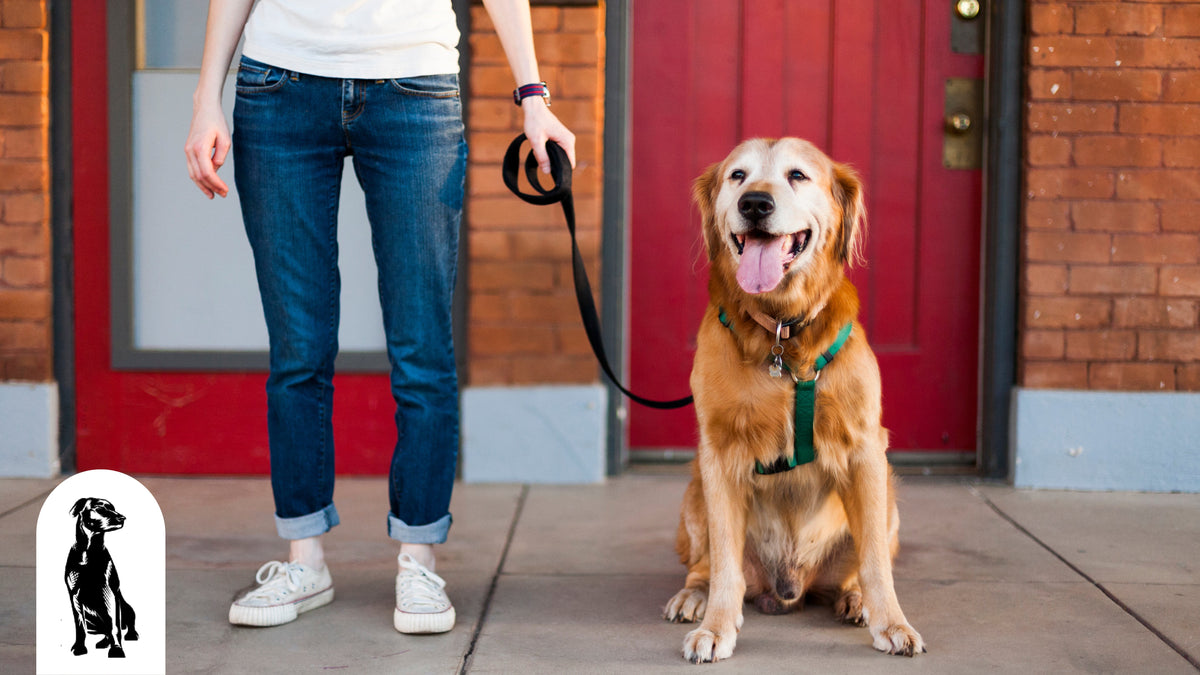
Whether you have a new puppy who you’re training to walk on a leash or an older dog who has some difficulty going on walks, it’s a good idea to consider training your dog to walk with a harness. It can be tough for canine beginners who aren’t so used to wearing a harness to acclimate to the sensation—but it can be a really valuable addition to your training!
When you walk your dog with a harness, the pull of the leash is distributed evenly across the dog’s chest, rather than focalized solely around the neck, as with a collar. This can make any dog more comfortable, but especially dogs that tend to pull on the leash. If you can teach your dog to enjoy walking with a harness, it can be easier for your pup to learn some easy dog tricks for beginners, as they will already be used to, and excited by, the training. Here are four simple steps to help you to harness train your dog.
Let your dog get used to the harness
Don’t start right away by trying to get your dog to put on the harness. Such a drastic introduction of something so new is likely to cause your pup some easily avoidable anxiety. Before you attempt to put your dog into a harness, allow your dog to familiarize themselves with the harness by leaving it hanging in your home, in a place your dog frequents. Put the harness on the floor, and allow your pooch to sniff and investigate it for a while.
Once they seem comfortable having the harness in their space, it’s time to start training your dog to have positive associations with their harness. Place the harness on the floor again, and put one of your dog’s favorite treats on top of it. When your puppy eats a treat off of the harness, this acts as positive reinforcement, showing your dog that when the harness is present, they get to have or do things they enjoy.
After doing this until your dog seems comfortable, start getting your dog used to feeling the harness. When your pup is feeling happy and energetic, gently tap the harness against the different parts of their body that it will be in contact with, such as the chest, sides, and back. While you do this, maintain a positive, easy attitude, give a lot of verbal praise, and give your dog treats regularly. Use the same positive, upbeat attitude you would maintain when training your dog to bark on command, or do any other fun tricks.

Put the harness on, and make sure it fits
Now that your dog is comfortable with the harness, it’s time for them to put it on! But first, make sure you’ve purchased the right one for your pup. There are generally two different kinds of harnesses:
1. Over-the-head harnesses
2. Step-in harnesses
Some dogs are generally calmer, or perhaps don’t mind having things passed over their heads, and for those dogs, it’s best to get an over-the-head harness. For more anxious pups, older dogs, or dogs with mobility issues, it can be easier for them to wear a step-in harness. Neither kind is definitively preferable; it all depends on what is easiest to put on your particular dog. Remember that safety is number one—once the harness is on and buckled, make sure that it’s tight, but that it’s easy for your dog to move around. You should be able to comfortably slip two fingers under any of the harness’s straps.
If your dog’s behavior changes abruptly when the harness goes on—for example, a normally active dog doesn’t want to move, or a dog who was energetic moments ago suddenly seems lethargic—then, there is a strong possibility that this particular harness is causing your dog pain, and they need one that fits differently. When you’re putting your dog’s harness on, make sure to give positive reinforcement and positive verbal commands. It might be useful to put the harness on and take it off again several times in a row so that the dog gets used to these sensations and isn’t upset the next time you try to put the harness on.
Ultimately, putting the harness on and taking it off should be easy, for both you and your furry friend. But, remember that at this point, you both are still beginners. It will take time for your pup to acclimate!
Let your dog get used to wearing the harness inside
Well, you beginners are taking strides! Onto the next step—once you have your dog in the harness, it’ll be tempting to pack them in the passenger seat right away for a trip into town, or off for an easy mountain to hike, but don’t give in to temptation just yet.
It’s important to let your pooch get used to wearing the harness in a place where they already feel comfortable roaming around, so let them wear it in the house for a while. If you’ve already taught your dog some easy tricks for beginners, perhaps have them practice them while wearing the harness so your dog can learn to associate wearing the harness with fun and positive reinforcement. One of the easy dog tricks for beginners includes sitting and shaking hands, and if your dog can learn to do these in and out of their harness, the harness will become a more natural part of their world.
If your dog is a puppy who is new to not only wearing a harness but taking walks altogether, try putting the leash on them while holding a treat, then allowing them to walk around the house with the leash hanging from the harness. This will allow them to get used to the sensation of being attached to a leash. Remember that as easy and fun as it may seem to you to walk your dog, being walked on a leash is not natural, so even the most enthusiastic pups need time to get used to the situation. Once your furry friend is comfortable in the harness, you can start doing some fun seasonal activities together!

Explore with your pup
You two aren’t beginners anymore! Now that your doggie is used to, and excited by, wearing the harness, it’s time to hit the town! Taking your pooch on regular walks is not only great and necessary for their health, it provides them the mental stimulation of experiencing the outside world—and it’s a lot of fun.
Once your dog is used to roaming the neighborhood in their harness, you should feel comfortable taking them on longer car trips, or even road trips! Make sure you get yourself a quality seat cover to protect your backseat, and as well as your furry friend’s paws. Help make it an easy—and exciting—experience for your both!
No matter which destination you go to, your dog will associate the harness with positivity, mental stimulation, praise, and fun—so they will be ready to take on all kinds of adventures and road trips with you, and impress folks far and wide with their tricks. Once your dog is harness trained, they will be better used to the training process, so they will likely take to learning other fun tricks with a greater amount of ease and enthusiasm. If necessary, it will also help you feel comfortable leaving your furry friend in the temporary care of another, because you’ll know anybody dog sitting for you will have a safe and easy time of taking your dog on regular walks.
You may have started as beginners, but look where you are now! Your dog is harnessed trained with a couple tricks under his belt (or, well, harness!), so the world is your oyster—and more importantly, you’ll know that you’re walking them in the safest, most comfortable way available, especially if they tend to pull on the leash.
